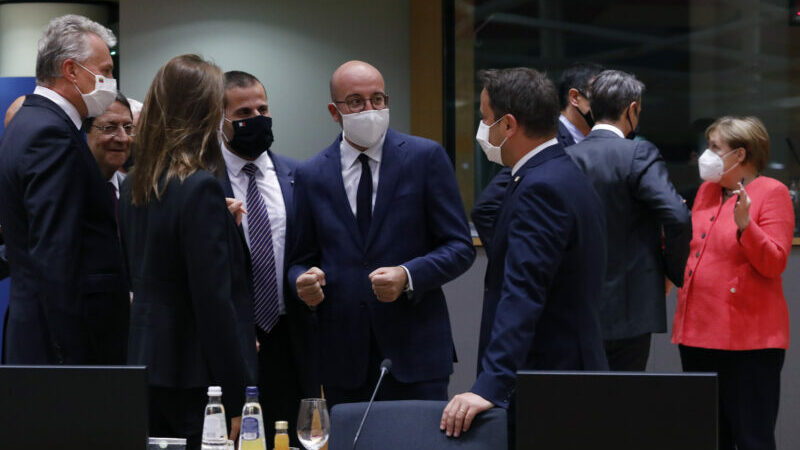In the early hours of 21 July, EU leaders agreed a deal on the new seven-year EU budget and the Next Generation EU recovery instrument.
The deal paves the way for a green and resilient recovery, with a commitment to 30% of funds going to climate projects and the “do no harm” principle applying to all spending.
It remains to be seen how that will be put into practice, with many important decisions left to member states.
In theory, “do no harm” should mean that no funding goes to projects that would harm the environment. In practice, there are still no real safeguards to ensure that recovery funds do not go to inefficient and polluting industries.
On top of that, climate and (more broadly) future-oriented spending took a hit in a spree of cuts to satisfy frugal member states.
The Just Transition Fund, to help communities built around polluting industries find new economic opportunities, has been more than halved, now standing at just €17.5 billion in comparison to €40 billion proposed earlier.
Horizon Europe, the EU’s flagship research and development program, was set to receive a top-up of €13.5 billion, now reduced to just €5 billion.
The Strategic Investment Facility, a new €31 billion window of InvestEU dedicated to strengthening the resilience of critical supply chains and helping the EU push for large-scale industrial transformation, was axed.
Climate news in your inbox? Sign up here
How green this deal will end up being now depends almost entirely on member states and their national recovery plans. To qualify for funding from the Recovery and Resilience Facility, €312.5 billion worth of grants, member states will have to submit plans setting out their reform and investment agendas until 2024. These plans will be pulled together over the coming months, to be submitted in October 2020.
One of the criteria against which the plans will be assessed by the Commission is whether they contain measures that effectively contribute to the green and digital transitions. But this should not be just about getting a passing grade. Members states have a chance to go well beyond the minimum 30% climate spend and to prioritize investments that really kick-start a green and resilient transition in their economies.
Three key elements will help them get there:
1) Realize green opportunities that build on existing strengths. As member states look for quickly scalable propositions to put into their plans they will worry about the pipeline of truly shovel-ready projects in the clean economy.
Luckily for them, the debate on EU climate targets and the Green Deal already triggered preparations of investment projects for a shift to climate neutrality. Think tanks and research institutions have been busily putting together reports and databases of all the many clean projects that could be invested in today.
A recent study by the Climate Friendly Materials Platform found an estimated €30 billion worth of shovel-ready projects in recycling and clean production of steel, cement, plastic and aluminum.
These could both contribute to the short-term objectives of revitalizing the economy and create jobs, as well as catalyzing the transformation towards enhanced resilience of value chains and the climate neutrality of the economy.
2) Don’t just think short term. Given the huge cuts to future-oriented research and innovation funding and the huge continuing need to scale up breakthrough technologies in key EU industries, member states will have to make up the shortfall in their own recovery plans.
The Climate Friendly Materials Platform study reveals just how critical public support will be for scaling up and developing breakthrough technologies in this sector, even more so with the costs and uncertainties the Covid-19 crisis has imposed on firms.
If longer-term market opportunities are combined with public co-funding, private investments can be unlocked and the multiplier effect of recovery spending increased.
3) Guidance on what qualifies and what doesn’t qualify as a green recovery plan. European funding has always been dedicated to policy objectives and ensuring that these are also well reflected in the new EU budget will be key.
It will be essential for countries to dedicate at least 30% percent of grants to stimulate economic activities that help industry, economies and societies to become climate neutral.
While the Commission will assess the plans on whether they contain elements that contribute to the green transition, there has been very little concrete detail on exactly how they will do this.
In the short term, it will be up to the European Parliament to set the parameters for providing more guidance on national plans and how to operationalize 30% climate spending and the “do no harm” principle. And for the Commission to respond quickly to provide clarification on which types of investment are acceptable and how to avoid contradicting green objectives and creating risks and costs for the future. The EU sustainable finance taxonomy offers a promising structure on which to build for this guidance.
Karsten Neuhoff leads the climate policy department at the German Institute for Economic Research (DIW Berlin). Johanna Lehne is a policy advisor at E3G.
